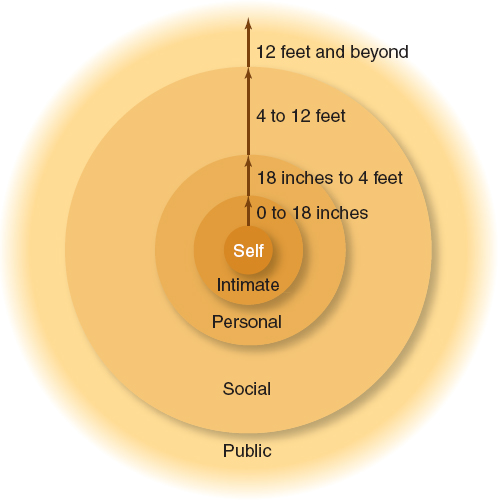Proxemics
Ben’s first job involved a coworker Lucas, who was a close talker—
Professor Edward Hall (1959) identified four specific spatial zones that carry communication messages (see Figure 4.2).
- Intimate (0 to 18 inches). We often send intimate messages in this zone, which is usually reserved for spouses or romantic partners, very close friends, and close family members.
- Personal (18 inches to 4 feet). In the personal zone, we communicate with friends, relatives, and occasionally colleagues.
- Social (4 to 12 feet). The social zone is most comfortable for communicating in professional settings, such as business meetings or teacher–
student conferences. - Public (12 feet and beyond). The public zone allows for distance between interactants at, for example, public speaking events or performances.

Your personal space needs may vary from the forgoing space categories. These vary according to culture too; Hall “normed” these zones for different cultures around the world. How close or distant you want to be from someone depends on whom you’re dealing with, the situation, and your comfort level. You might enjoy being physically close to your boyfriend or girlfriend while taking a walk together, but you probably don’t hold hands or embrace during class. Gender also plays a role. Research says that groups of men walking together will walk faster and typically leave more space between themselves and others than women will (Costa, 2010). But regardless of your personal preferences, violations of space are almost always uncomfortable and awkward and can cause relational problems (Burgoon, 1978).
Proxemic messages are not limited to the real world. In the online virtual world Second Life, you create your own space in which you and your avatar move. Avatars use proxemic cues to send relational messages and structure interaction, much as people do in real life (Antonijevic, 2008; Gillath, McCall, Shaver, & Blascovich, 2008).